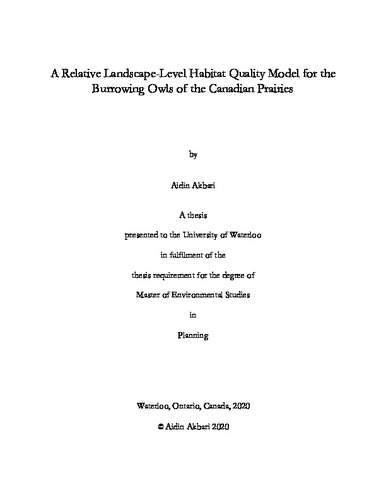| dc.description.abstract | The range and population of the Burrowing Owls as flagship migratory species of the open prairie
landscape are in decline across the northernmost portion of their global range in Canada. Multiple
sources of degradation, including those induced by human footprint, are attributed to this declining
trend. Yet the degradation caused by these factors is yet to be quantified and mapped at the
landscape-level.
Using the InVEST habitat quality model, the habitat quality values for these endangered birds were
quantified, mapped, and evaluated across both the historic and current ranges of these species in the
Canadian Prairie ecosystem. In doing so, four different general categories of disturbance, namely the
modified landscape, transportation network, urban areas, and energy infrastructure were considered.
Also, variations of habitat quality values were modelled across the current range of these species
upon the consideration of the different combinations of these sources of disturbance at this spatial
extent.
The results of the study illustrate that despite the differences in the relative habitat quality values
between the historic and current ranges of Burrowing Owls, these variations are not statistically
significant between the two ranges when all sources of degradation are considered concurrently in
the study area. Across the current range, also, the difference in habitat quality values is not
statistically significant between the considered scenarios, even when specific habitat patches are
assessed.
Nevertheless, the habitat quality was most affected by the transportation network data layer,
followed by the energy and urban data layers. Consequently, the delineated spatial sources of
disturbance can only be considered to have intensified the synergistic association between the other
factors attributed to the decline of these species including the prolonged impact of grassland
iv
conversion activities of the past, which has altered the configurational characteristics of the
landscape, as well as to the other environmental factors affecting the population of these endangered
species across the study area and beyond.
Considering the existing composition of land use/cover and share of specified sources of
disturbance in habitat quality degradation across the current range of Burrowing Owls, conservation
measures can be applied beyond the designated critical habitat boundaries for these species to
preclude the potential future impacts of these sources of degradation. Further studies are still
required to assess habitat quality values under the anthropogenic sources of degradation beyond the
considered spatial extent and with regard to the other sources of disturbance across the global range
of these species. | en |

